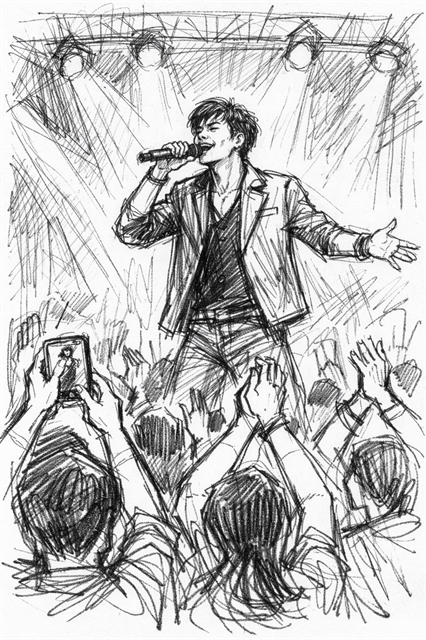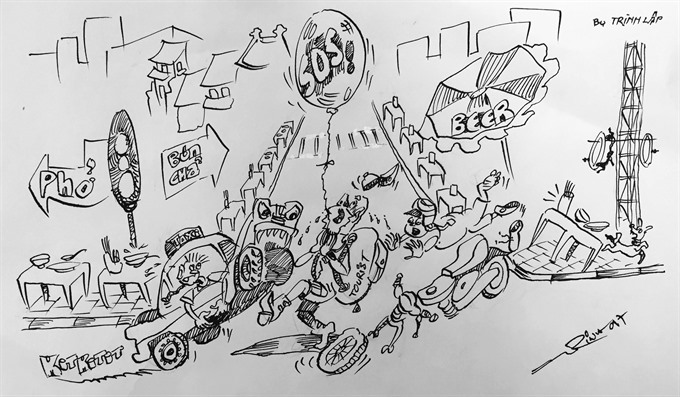 Talk Around Town
Talk Around Town

Over the past fortnight district authorities have worked hard to free up pavements to return them to whom they belong – pedestrians — as well as improve the city’s beauty.
 |
| Illustration by Trịnh Lập |
By Thu Ngân
“What is the hottest news these days?”
Ask the residents of HCM City this question, and I am sure 99 per cent will point to authorities’ decision to clear all pavements of encroachments.
In my five years in the city I have never seen any action have such an impact as this.
Over the past fortnight district authorities have worked hard to free up pavements to return them to whom they belong – pedestrians — as well as improve the city’s beauty.
Nguyễn Thành Phong, chairman of the People’s Committee, has promised the task will be carried out in all 24 districts to create a “civilised and modern” city with high living standards.
District 1, whose stated aim is to transform the heart of city into a "little Singapore," has been the leader in the pavement clearance.
Its leaders have personally gone around to oversee the task. They have thrown the book at the owners of luxury cars that were illegally parked there and dismantled many illegal hoardings.
On March 1st they gave notice to restaurants and shops that they have 10 days to clean up and move their businesses out of pavements.
This tough action around the city has shocked vendors and many foreign tourists who love the unique pavement culture they find on Tây streets (where foreigners flocks to the many bars and shops) like Bùi Viện.
Many vendors on these streets are devastated by the authorities’ decision.
Mỹ Dung, who has sold hủ tiếu (rice noodle) for 20 years on Bùi Viện Street, is in tears saying her family survives on her income and she does not know how she will feed them if she is not allowed to sell on the pavement.
Other pavement businesses like coffee shops lament that customers will no longer patronise them if they are not allowed to sit on the pavement.
Visitors to the city are not too impressed by the campaign.
An Australian tourist told news.zing.vn that he came to Việt Nam for several things.
“Sitting outside, eating outside, eating street food: If that is lost, Sài Gòn looks like anywhere else.”
I myself love street food and eating on Vietnamese streets is an awesome experience.
It is an amazing feeling sitting on a pavement and enjoying traditional foods at noon when we have a one- or two-hour break from work.
The delightful feeling of eating bún đậu mắm tôm (rice vermicelli cakes and shrimp sauce) or miến cua (crab noodle) at noon in autumn, I am sure, cannot be found anywhere else in the world except Việt Nam.
But this is not to say I disagree with what the authorities are trying to do: In fact, I wholeheartedly approve.
Seeing what is happening on TV and newspapers makes me very happy for it is a clear sign that the city is trying to catch up with modern cities around the world.
I am sure most Vietnamese wonder at least occasionally why their cities, in this case HCM City, cannot be modern and beautiful like cities even in their own region.
But how can a city be beautiful when its streets are littered with rubbish discarded by vendors and their customers? How can a city be modern and safe when pedestrians have to share the carriageway with motorbikes and cars because pavements are occupied by street vendors and households?
Equally importantly, how can a city be called modern when food hygiene is compromised because vendors are mushrooming everywhere?
Văn Quốc, a HCM City reader of news.zing.vn, wrote to say that if livelihoods are taken as an excuse not to tidy up pavements, they – the pavements — cannot be used by pedestrians for the next 10 or 20 years.
Things need to be changed so that the city can be made more “civilised,” and while many people would face difficulties, they would have to accept and find a way to change, he said.
Many people consider pavement vendors a unique cultural feature of the city. Sure they have been around for at least a few decades and become part of the scenery.
Getting rid of pavement stalls might even give rise to a new culture: eating bún đậu mắm tôm or a bowl of phở in a small shop in a small lane or even on a flower-filled balcony.
From there you can still admire and enjoy a slice of HCM City.
In fact, it may already be happening. Many people have opened food and beverage shops in small apartments in old buildings, and these are attracting lots of customers besides becoming trendy among young people.
The city authorities have been talking about clearing pavements for a long time, but always baulked when it came to action because they sympathised with the vendors.
But it looks like it is finally going to happen. More power to them!
But I am sure they have alternative plans for the affected vendors, and might create walking-only streets to sustain this slice of HCM City culture.
I liked what one official said: “We should not stop with just discussing. Do it!”
Yes, it is indeed time to act.
If one were to be candid, the hawkers are not being deprived of anything rightful, and they are merely returning what never belonged to them in the first place. VNS